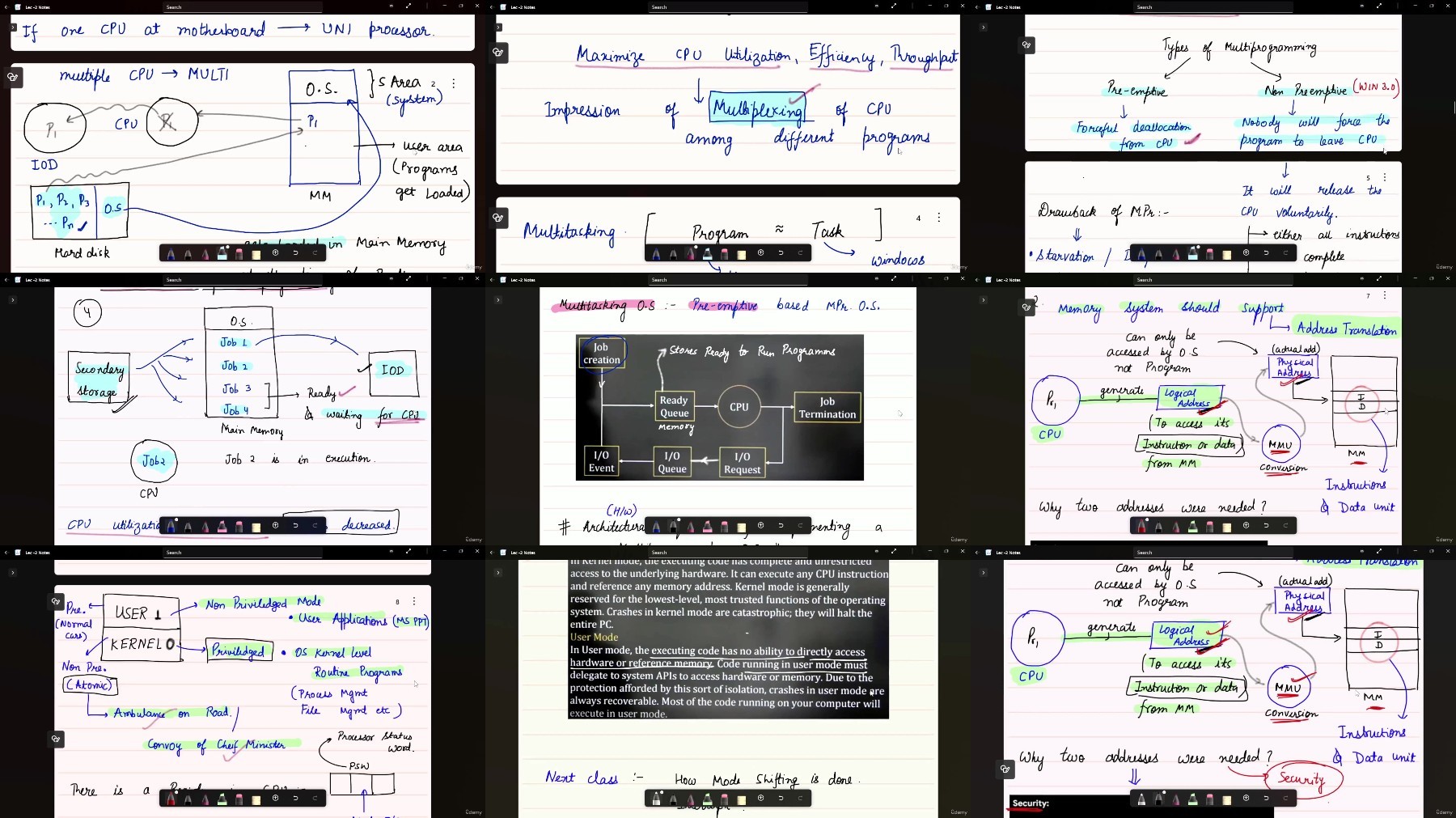Operating System: Make Your Fundamental Rock Solid+Pdf Notes

Operating System: Make Your Fundamental Rock Solid+Pdf Notes
Published 4/2024
MP4 | Video: h264, 1920x1080 | Audio: AAC, 44.1 KHz
Language: English
| Size: 5.82 GB[/center]
| Duration: 8h 46m
Academically Oriented Operating System Advanced Course : Mastering Core Concepts with 100+ Top Notch Examples
What you'll learn
Academically Oriented & Comprehensive Understanding : This is the most detailed OS course on this Platform.
Conceptual Clarity: You will solve loads of Practice Questions that will make your concepts crystal clear.
Enhanced Problem-Solving Skills: Learn to analyze and solve complex OS-related problems
You will appreciate the depth of the course content, covering a wide range of topics in OS with meticulous attention to detail.
Requirements
Little bit of C and COA concepts.
Description
This course represents the epitome of comprehensive learning available on this platform, a claim I can confidently stand by. Every effort has been dedicated to delving into the minutiae of the subject matter. Leveraging Numerical and Practice Sessions, I've endeavored to fortify your understanding of OS concepts and foundational principles. The breadth of topics covered is extensive, and even if you possess a rudimentary understanding of OS, you'll undoubtedly appreciate the depth this course explores:Curriculum : 1. Introduction and Background: a. Defining an OS: Elucidated through 5 Definitions Von Neumann Architecture Stored Program Concept Significance of Main Memory OS as Interface OS Kernel OS as Resource Manager OS as Control Program b. Types of OS: Uni-programming and Multiprogramming Degree of Multiprogramming Addressing CPU Idleness Throughput Schematic View of Multiprogramming Types of Multiprogramming OS Comparison between Multiprogramming and Multitasking OS Architectural Requirements for Implementing Multitasking OS Kernel & User Mode c. User and Kernel Mode Shifting: APIs Fork system call Interrupt ISR PSW Types of Functions Perspective on Mode Shifting2. Process Management: a. Understanding Processes: Distinguishing between program and process Key C Concepts 7 Definitions of Process Treating Process as an ADT (Abstract Data Type) Various Process Operations Process Attributes and PCB b. Process Transition Diagram: Different Process States Process State Transition Diagram Introduction to Schedulers and Dispatchers Addressing Common Doubts c .Scheduling Queues and State Queuing Diagrams: Detailed Examination of Schedulers and Dispatchers Context Switching3. CPU Scheduling: a. Introduction and Process Times: Implementation of Short-Term Schedulers Functions and ObjectivesUnderstanding Process Times (AT, BT, TAT, IOBT, CT, Schedule Length) b. FCFS: Selection Criteria Operational Mode Conflict Resolution Assumptions Challenges with FCFS Scheduling Gantt Chart % CPU Idleness and Efficiency c. FCFS with Dispatch Latency and IOBT: Addressing the Most Complex FCFS Problems Regular Discussion of Home- Work Problems d. Shortest Job First ( Preemptive and Non Preemptive Case ) Selection Criteria Operational Mode Conflict Resolution Assumptions Challenges with FCFS Scheduling Gantt Chart % CPU Idleness and Efficiencye. HRRN f. LRTFg. Round Robin and Performance Discussionh. Priority Based Schedulingi. Multilevel Queue Feedback Scheduling
Overview
Section 1: Introduction and Background
Lecture 1 What actually is OS, Its functions and goals.
Lecture 2 Multiprogramming OS , Schematic View of Multiprogramming OS & Modes in OS
Lecture 3 Problem Solving Session ( DPP-1)
Lecture 4 Mode Shifting , Interrupt & System Calls
Lecture 5 Problem Solving Session ( DPP - 2 )
Section 2: Process Management
Lecture 6 Program Vs Process || Process as ADT
Lecture 7 PCB ||Process States || Process Transition Diagram
Lecture 8 Process Transition Diagram - Part 2
Lecture 9 State Queuing Diagram || Schedulers and Dispatchers || Context Switching
Section 3: CPU Scheduling
Lecture 10 Introduction and Process Times
Lecture 11 First Come First Serve Algorithm + Practice Questions
Lecture 12 FCFS with Dispatch Latency and IO Burst Time
Lecture 13 FCFS Last Part
Lecture 14 FCFS Home Work Questions Discussion
Lecture 15 Shortest Job First
Lecture 16 Shortest Remaining Time First
Lecture 17 Shortest Remaining Time First - Part 2
Lecture 18 Techniques for Prediction of Burst Times
Lecture 19 Highest Response Ration Next ( HRRN )
Lecture 20 Longest Remaining Time First
Lecture 21 Priority Based Scheduling
Lecture 22 Priority Based Scheduling Part 2
Lecture 23 Round Robin Scheduling
Lecture 24 Performance of Round Robin Scheduling
Lecture 25 Multi Level Queue Scheduling
Section 4: Process Synchronization / Coordination
Lecture 26 IPC and Introduction To Synchronization
Lecture 27 Exploring Race Condition
Lecture 28 Producer and Consumer Problem Implementation
Lecture 29 Which type of Sync in Producer & Consumer Problem ?
Lecture 30 Necessary Conditions for Sync Problems
Lecture 31 Requirements for Sync Problems
Lecture 32 Introduction to Sync Mechanism
Lecture 33 Lock Variable - 1
Lecture 34 Lock Variable - 2
Lecture 35 Lock Variable - 3
Lecture 36 Strict Alternation ( Turn Variable )
Lecture 37 Implementation of Peterson Solution
Lecture 38 Analysis Of Peterson Solution
Lecture 39 HomeWork Question Discussison
Lecture 40 Dekker's Algorithm
Lecture 41 Introduction to Hardware Solutions
Lecture 42 Test & Set Lock
Lecture 43 SWAP - Lock and Key
Lecture 44 Priority Inversion Problem
University Students,GATE Aspirants,Those who want to make their OS Fundamentals Rock Solid

https://voltupload.com/nw5ba7kwcw4x/Operating_System_Make_Your_Fundamental_Rock_SolidPDF_Notes.z01
https://voltupload.com/v4qswl73demn/Operating_System_Make_Your_Fundamental_Rock_SolidPDF_Notes.z02
https://voltupload.com/uhseljrybv5x/Operating_System_Make_Your_Fundamental_Rock_SolidPDF_Notes.z03
https://voltupload.com/uxwk90hsw93d/Operating_System_Make_Your_Fundamental_Rock_SolidPDF_Notes.z04
https://voltupload.com/w1otq5f6gjll/Operating_System_Make_Your_Fundamental_Rock_SolidPDF_Notes.z05
https://voltupload.com/pw06ou29wrwa/Operating_System_Make_Your_Fundamental_Rock_SolidPDF_Notes.zip
https://rapidgator.net/file/8a77c2faf02f9560f5a3120f46e5b9f9/Operating_System_Make_Your_Fundamental_Rock_SolidPDF_Notes.z01
https://rapidgator.net/file/97ce5192ca9d153f9839e8df71b6a483/Operating_System_Make_Your_Fundamental_Rock_SolidPDF_Notes.z02
https://rapidgator.net/file/f5c12d4a64834f200e67fe7589edc083/Operating_System_Make_Your_Fundamental_Rock_SolidPDF_Notes.z03
https://rapidgator.net/file/7fd5123ece4c888b42c574db0b9293a9/Operating_System_Make_Your_Fundamental_Rock_SolidPDF_Notes.z04
https://rapidgator.net/file/15770d72ccfc86190d50226345f388ef/Operating_System_Make_Your_Fundamental_Rock_SolidPDF_Notes.z05
https://rapidgator.net/file/a3aefa1f2081f22cef3b8dae1df73f4b/Operating_System_Make_Your_Fundamental_Rock_SolidPDF_Notes.zip
Free search engine download: Operating System Make Your Fundamental Rock SolidPDF Notes
